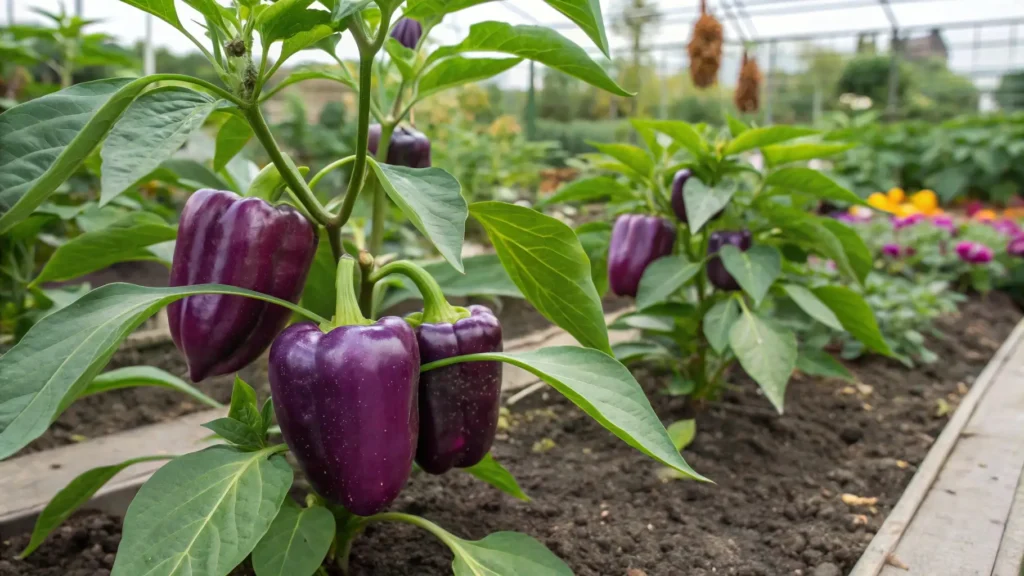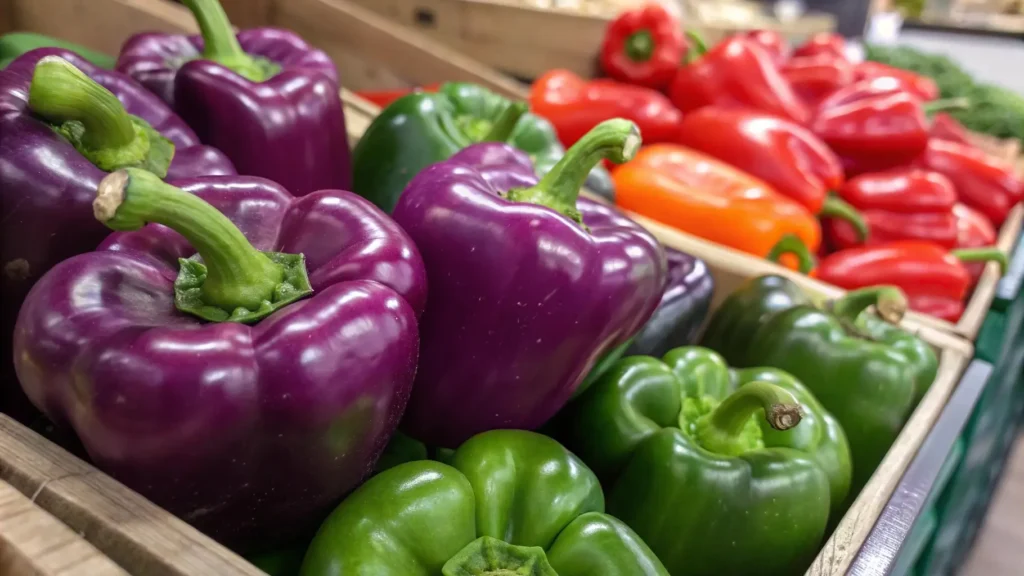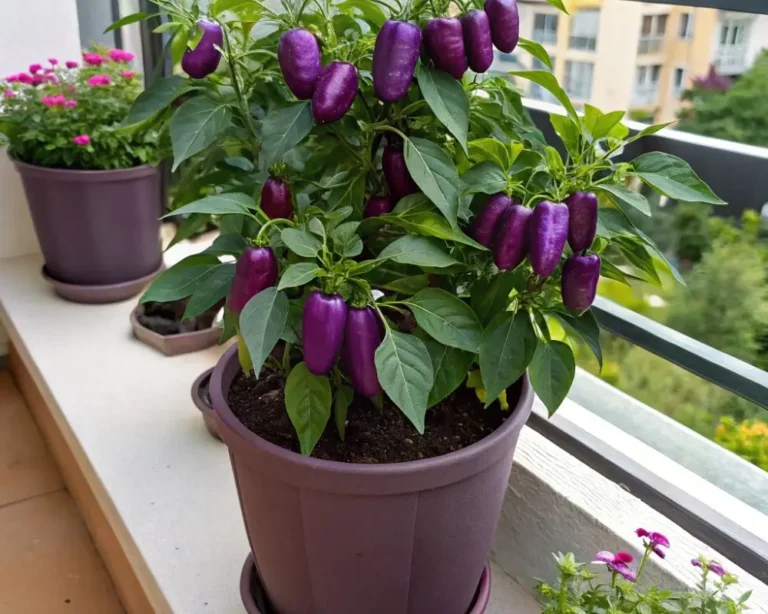Purple peppers—they’re the eye-catching stars of the pepper world, but what makes them stand out from the usual green or red peppers? Is it their unique flavor, their health benefits, or that vibrant purple color? Whether you’re a gardener looking to try something new or a foodie curious about bold flavors, these peppers are worth the attention.
In this post, we’ll explore what sets purple peppers apart, how they compare to other peppers, and why you should consider adding them to your garden or kitchen. Let’s dive in!
Table of Contents
What Makes Purple Peppers Special?
Purple peppers aren’t just a pretty face in the pepper world. Their vibrant color and unique flavor make them a standout choice for any garden or recipe. But what exactly makes them different from the usual green or orange peppers? Let’s take a closer look.
Color That Packs a Punch
That striking purple color isn’t just for show. It comes from anthocyanins—powerful antioxidants that also give blueberries their color. These antioxidants help fight inflammation and protect against cell damage, giving purple peppers an extra health boost.
Flavor with a Twist
While purple peppers have a similar taste to red or green peppers, they’re often milder and sweeter. They bring the pepper flavor without overwhelming your dish, making them perfect for those who like a subtle kick.
Health Benefits
These peppers are more than just a treat for the eyes and taste buds. They’re packed with vitamins A and C, essential for a strong immune system. Plus, their high antioxidant content and fiber support digestion and overall wellness.
Growing Purple Peppers: Tips for Success

1. Find the Perfect Spot
These peppers love sunlight. Aim for at least 6–8 hours of direct sunlight each day. The more sun, the better the peppers will grow and develop their signature purple color.
- Tip: Ensure the soil drains well—these peppers dislike soggy roots.
2. Prepare the Soil
These peppers thrive in nutrient-rich, slightly acidic soil. Add compost to boost the soil’s health, and check the pH—aim for 6.0 to 6.8 for the best growth.
3. Water Consistently
Water your peppers deeply, but let the soil dry out between waterings. Avoid soggy soil to prevent root rot.
- Tip: Water in the morning to give your peppers a healthy start to the day.
4. Fertilize for Healthy Growth
Use a balanced fertilizer once a month to keep your peppers strong. Just don’t overdo it—too much fertilizer can lead to more leaves and fewer peppers.
5. Support and Prune
As they grow, stake your purple peppers to keep them upright. Prune dead leaves to promote better airflow and healthy growth.
6. Harvesting
these peppers are ready to pick in 70–90 days. Wait for the color to deepen and the peppers to feel firm before harvesting.
Purple Peppers vs. Other Peppers: The Flavor Showdown

When it comes to peppers, the color might be the first thing that catches your eye, but what about the flavor? How do purple peppers stack up against the more familiar green, red, or yellow varieties? Let’s dive into the flavor showdown to see what makes these peppers truly unique—and why you might want to swap your usual pepper for one that’s a little more exciting.
1. Flavor Profile: Sweet vs. Spicy
Purple peppers tend to be milder and slightly sweeter compared to their green or red counterparts. If you’re a fan of peppers but find some varieties a bit too fiery, these peppers might be the perfect middle ground for your taste buds.
- Tip: While purple peppers aren’t usually as hot as, say, jalapeños or habaneros, they still pack a punch—just not a burn-your-mouth kind.
Green peppers, on the other hand, can be a bit more bitter, while red peppers bring a juicy, sweet flavor when fully ripe. But purple peppers? They sit comfortably in between, offering a mild sweetness with just enough zing to keep things interesting.
2. Texture: Crisp with a Twist
Texture plays a big role in the eating experience. Purple peppers, much like their red and yellow cousins, have a firm, crisp texture. They’re not too crunchy or too soft, making them perfect for stuffing, grilling, or even tossing into a salad.
- Pro Tip: If you’re making a stir-fry, purple peppers hold up nicely without getting mushy, giving your dish a satisfying bite.
In contrast, green peppers can be a little tougher, especially if they’re harvested before fully ripened. They might lose some of their crunch when cooked. Red peppers, on the other hand, have a smoother, softer texture, especially when roasted or grilled.
3. Culinary Uses: More Than Just a Pretty Face

These peppers are versatile in the kitchen—whether you’re grilling them, adding them to salads, or even stuffing them, their subtle sweetness complements a wide range of dishes. Their striking color makes them a showstopper in any recipe, so if you’re looking to add a bit of flair to your food, these peppers will do the job.
- Tip: Try purple peppers in a salsa for a colorful twist. Their mild flavor pairs well with the tang of tomatoes and the heat of other peppers.
When comparing to red peppers, purple peppers stand out in the visual department, but red peppers tend to bring a bolder sweetness. Yellow peppers are similar to red, but with a slightly milder touch. purple peppers sit comfortably in between—flexible enough to work in most recipes, but with that unique touch of color and flavor.
4. Why You Should Choose these peppers
If you’re craving a pepper that’s a little more subtle than the fiery red or green, purple peppers offer the perfect balance. Their versatility in flavor, texture, and color makes them an exciting ingredient to experiment with—whether you’re a seasoned cook or a beginner in the kitchen.
For more information on supporting and pruning peppers, check out this great guide on ornamental peppers, where you’ll find tips on staking them and trimming dead leaves to improve airflow and promote healthy growth: Ornamental Peppers – Gardening Solutions.
Conclusion:
Are purple peppers worth adding to your garden and kitchen? Definitely! These vibrant veggies offer a unique flavor—mild and sweet—that works in a variety of dishes, from fresh salads to roasted side dishes. Their stunning color isn’t just for show; it brings beauty and flavor to everything they touch.
Whether you’re growing them or cooking with them, these peppers are a versatile addition to your collection. They’re easy to grow, fun to use, and they add a little extra flair to your meals. Ready to experiment with purple peppers? You won’t regret it!
FAQ:
What do purple peppers taste like?
These peppers have a mild, slightly sweet flavor. They’re less bitter than green peppers but not as sweet as red or yellow peppers. Their taste is subtle, making them perfect for a variety of dishes without overpowering other flavors.
How do I grow purple peppers?
These peppers thrive in well-drained soil with plenty of sunlight. They need at least 6–8 hours of direct sunlight a day and a slightly acidic soil pH (around 6.0 to 6.8). Water them consistently but allow the soil to dry out between waterings to avoid root rot.
Are purple peppers hotter than other peppers?
No, These peppers are generally milder compared to other varieties like jalapeños or habaneros. While they have a slight zing, they aren’t typically spicy, making them a great option for those who prefer a sweeter, less fiery pepper.
Can I eat purple peppers raw?
Yes!These peppers are delicious raw. Their crisp texture and mild sweetness make them a great addition to salads, salsas, or just as a crunchy snack. They’re also perfect for dipping in hummus or your favorite dressing.


1 thought on “Purple Peppers vs. Other Peppers: Why They’re Best Choice !”